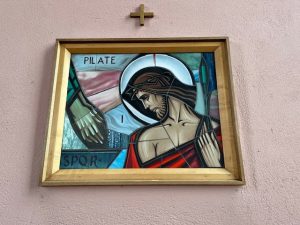This page is a tour of Corpus Christi Catholic Church in Clifton, Nottingham, England.
It shows what you can see around the church and describes some of the items used in Church services.
The church appears cruciform i.e shaped like a cross but when looked at in plan format there are extra additions to the cruciform shape.
The Apse
In Romanesque and Gothic churches the semicircular end of the sanctuary that terminates the chancel, aisles or transepts is known as the Apse. In Corpus Christi the term is being used to describe the back wall of the church behind and beyond the Sanctuary.
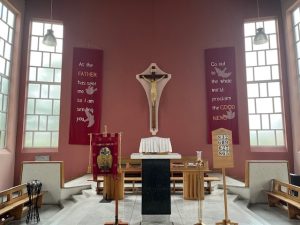 |
The Cross in the Apse draws your attention wherever you are in the church.
A cross bearing the image of Christ either as suffering Saviour or as risen Lord is known as a crucifix. A measure of its importance is that a crucifix must be on or over the altar where the most sacred of services, the Mass is celebrated.The Cross is a term used to describe the instrument of suffering on which Christ died for the salvation of the world. The Cross is a symbol of Christ’s redeeming love, profoundly respected by Christians throughout the world. |
| Also in the Apse are the foundation stones. The first was laid when the church was being erected. The second marks the occasion of the consecration of the church. |
The North Transept
To the left of the Sanctuary is the North Transept.
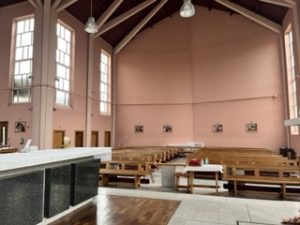 |
On the left as we turn into The North Transept are the Confessionals. There is a small room behind each door. The priest sits in one room, the person seeking reconciliation in the other.
The sacrament of penance is a personal encounter with Jesus Christ represented by the priest (a legitimately ordained minister) in the confessional or reconciliation room. The rite is called reconciliation because the penitent is reconciled not only with God but with the Church community. The forgiveness is obtained through the absolution imparted by the priest. The priest acts as both judge and healer in the sacrament of penance; he is to act with prudence and fidelity to the magisterium of the Church. The priest’s obligations under the sacramental seal are stated in Canon Law: “…it is a crime for a confessor in any way to betray a penitent by word or in any manner or for any reason.” |
| This is a view into the confessional where the penitent admits to God that he or she has sinned, makes an act of sorrow, accepts a penance (prayers, acts of self-denial, or works of service to others) and resolves to do better in the future.
When Pope John Paul II visited the UK and Ireland in 1982 he visited Dublin and Liverpool among other places. In Dublin he said, “When I heard that you were preparing for my visit by going to Confession you could not have given me a greater gift”. In Liverpool he included this in his address; “There is no sin which cannot be forgiven if we approach the throne of mercy with humble and contrite hearts. No evil is more powerful than the infinite mercy of God.” |
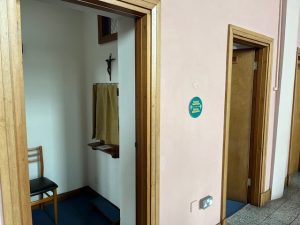 |
On the back wall are a series of pictures depicting Jesus journey to Calvary where he was crucified. The journey is known as the Way of the Cross. The pictures depict events on that journey and, because they are there to encourage us to stop and think, are known as Stations. There are fourteen Stations altogether. Four are in the North Transept, six are in the knave and four are in the South Transept. They are reproduced with some ideas to ponder as you move from one to another. The reflections are based upon some brought to us by Miss Una Doyle, a Diocesan Youth Officer.
| 1. Jesus is condemned to death
|
The start of a daunting journey with the crowd screaming and demanding only one outcome from Jesus’ meeting with Pilate: that Jesus should die. Why did this happen? How was Jesus feeling in the midst of such anger?
Have things changed much? Who speaks up for the weak and defenceless? Are individuals ridiculed, if not condemned, for what they believe to be right?
|
| Having been condemned, beaten up, scourged and mocked, Jesus had to accept his cross to carry it to the place of execution. A heavy burden and a painful one too with, no doubt, sharp splinters digging in. But it had to be done.
No one is spared from pain of some sort. Sometimes we have to accept the situation. That does not mean we have to give up. Let us pray for the courage to keep going, to accept our cross as Jesus accepted his.
|
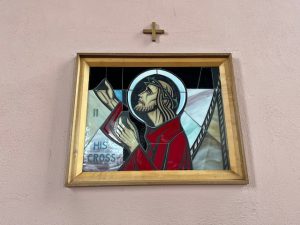 2. Jesus accepts the Cross |
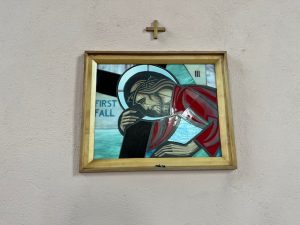 3. Jesus falls the first time |
How many times have we fallen, failed to do what we know to be right? What are the things that might cause us to fall – drugs, alcohol, behaviour? Who tripped us up? Who helped us when we were down? Do we feel we want to try to make amends or do we want to give up trying? Have we tripped others up? |
| Have I caused my parents hurt and grief? How many times have I hurt others in my family? Have they hurt me? Was any of this deliberate? What is it like to stand by and watch somebody suffer knowing that you cannot help them or reach them? | 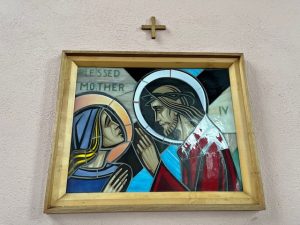 4. Jesus meets his Mother |
The Sanctuary
The Sanctuary is that part of the church where the priest, servers and other ministers have places to perform their functions in the liturgical rites. It is a sacred part of the church and is set off from the rest of the church by a raised floor. It is where the altar, tabernacle and lectern are found. Details of these and other items that may be seen in the Sanctuary are given on this page, below.
The main liturgical rite which takes place in the Sanctuary is the Mass, the summit and source of all Christian worship and life. For an explanation of the Mass, click on the button “Explanation of the Mass” below.
It has become customary for the colours worn at Mass to change according to the liturgical season or for particular feast. For an explanation about the colours worn at Mass click on the button “Colours Worn” below.
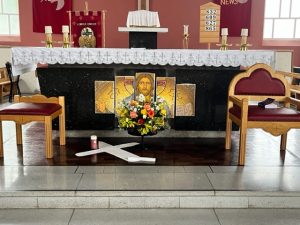 |
The altar is a table on which the Eucharistic Sacrifice is celebrated. An altar may be fixed (joined to the floor) or movable (able to be transferred.) According to Catholic custom the table of a fixed altar is made of stone. A movable altar can be constructed from any solid material appropriate for liturgical use.
During the celebration of the Eucharist an altar cloth, usually of white linen or other suitable material, covers the entire altar. A cross bearing the image of Christ either as suffering Saviour or as risen Lord is known as a crucifix. A crucifix must be on or over the altar where Mass is celebrated. As the large crucifix in the Apse is not above the altar, a small crucifix is placed in the centre of the altar to meet this requirement. Candles symbolise divine life and purity. Lighted candles are placed on the altar during the celebration of the Mass to indicate Christ’s presence. |
| The altar stone is used as a term to describe the small square of flat stone, consecrated by a Bishop, that contains the relics of canonized martyrs or saints. It is usually inserted in the centre of an altar that is blessed.
The ancient tradition of keeping the relics of martyrs and other saints under a fixed altar is required under the Church’s rules, known as Canon Law, to be preserved according to the norms given in the liturgical books. |
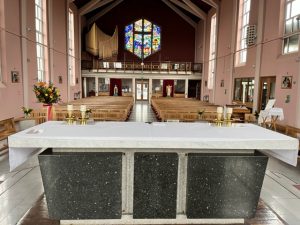 |
| The round, flat wafers used in the Eucharistic Liturgy are known as altar bread. The unleavened bread is made of pure wheat flour mixed with water and baked between iron moulds.
The altar wine contained in a Chalice (like a goblet) when used for the Eucharistic Liturgy must be made from grapes, natural and unadulterated, that is, not mixed with any additives. A small quantity of water is mixed with the wine by the priest at Mass. Symbolic meanings associated with this action are the union of Christ with the people of God and the union of the human and divine in Jesus. |
|
| In the centre of the Sanctuary behind the altar is the tabernacle. The tabernacle is a receptacle for the exclusive reservation of the Most Holy Eucharist, that is the Real Presence of Jesus in the form of bread. We genuflect on entering church in recognition of this and as a sign of adoration and reverence. According to the Code of Canon Law (the Church’s rules), the tabernacle “should be placed in a part of the church that is prominent, conspicuous, beautifully decorated, and suitable for prayer; it should be immovable, made of solid and opaque material, and locked so that the danger of profanation may be entirely avoided.”
The tabernacle is often covered with material of the same colour as the priest’s vestments. For details of the colours used and when click on “Colours worn” above. |
 |
| A special lamp (often called the sanctuary lamp) “to indicate and honour the presence of Christ is to burn at all times before the tabernacle in which the Most Holy Eucharist is reserved”. | |
| Also on the sanctuary, its position depending on the time of year, is the paschal candle. The word “paschal” refers to the passion death and Resurrection of Jesus Christ, the Lamb of God, by which he brought about salvation for all humankind. The paschal candle is the Easter candle, marked with a cross, Alpha and Omega it stands as a symbol of Christ rising from the dead and to signify that Christ is the Light of the World. The paschal candle is first lit at the opening of the Easter Vigil, on every Sunday in the Easter Season and at Baptisms and Funerals. | 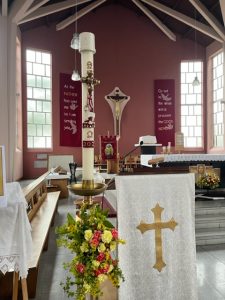 |
The South Transept 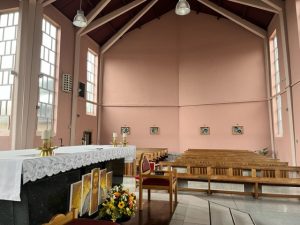
The South Transept provides the link between the Sacristy and the Sanctuary. There is seating here for around 70 people. On the wall of the South Transept are the last four of the Stations of the Cross.
| 11. Jesus is nailed to the cross | “Father forgive them for they know not what they do.”
How many people are bullied in one way or another in my school, in my workplace, in my world? Do I accept violence around me? How many people are crucified daily because of their race, colour or creed, or because they don’t seem to fit in? |
| “Father into your hands I commend my spirit”.
It is too late, the damage is done. Do we say this about people and situations we have known? If so: Why did we stand by and not help? Why did we not act justly towards others? Why did we not try to work, however quietly, to lessen the violence around us? Did we walk away from the situation instead? |
12. Jesus dies on the Cross |
| 13. Jesus is taken down from the Cross | What is left? Who is left? What are people doing?
The same questions could be asked at the low points of our lives. Perhaps it is time to consider what it is that is really important to us. Who can we really count on? Will some who we thought of as friends leave us high and dry in our hour of need? |
| The journey is complete. There is nowhere else to go. This seems to be the end. The hopes, the aspirations, the expectations of Jesus’ friends were buried with Jesus on that day. Everything they had worked for seemed to have gone in the moment that the stone was rolled across the tomb.
A time of hurt, of emptiness, of despair if this was indeed the end. Could we use the tomb not to bury our hopes but to bury our fears? Not to bury our aspirations and expectations but to bury our own interest in self? Not to be a symbol of despair but a symbol of what is to come? Not to feel empty but to be filled with Christ’s love so that others may come to know him and through him receive eternal life?. |
14. Jesus is laid in the Tomb |
The Nave 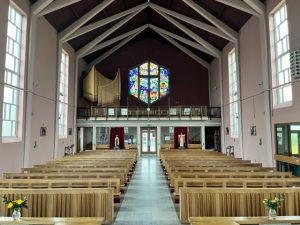
The Nave is the part of the church we first enter from the porch. It is where the majority of the congregation are. Entrance to the Lady Chapel is on the left as you enter.
The Stations of the Cross, the first four of which are in the North Transept, continue in the Nave. Stations 5, 6 and 7 are on the north wall, stations 8, 9 and 10 on the South wall. The final four stations are found in the South Transept The stations give us a chance to stop and reflect on Christ’s journey to Calvary. They are reproduced below with some thoughts for our own personal reflection.
| 5. Simon helps Jesus carry his cross | Who helped me carry my cross? Was it visible to others? Did I accept or refuse the help?
Did I see someone else in trouble,broken and bleeding and just walk past or did I seek to help whether I knew the person or not? Why did the man known as Simon help Jesus? Who is carrying a cross in my community today? How can I help? |
| Would we have comforted Jesus or was the scene too horrible to look at properly? Do I see Christ in others and comfort them in their distress? What would I have said to Jesus? What do I say to others? | 6. Veronica wipes the face of Jesus |
| 7. Jesus falls the second time | Does the pressure to keep going sometimes get too much?
Do events on our journey get harder and the tasks appear more difficult, to the point that we want to give up? Who is there to pick us up and encourage us? |
| “Weep for yourselves and for your children”.
Jesus foresaw sad things happening if people kept rejecting God and doing wrong. What example do we give to our brothers and sisters and friends? Do our friends think of us as trustworthy and good? Do we try to sort good advice from bad? If we receive good advice do we find it difficult to follow it? |
8. Jesus speaks to the women and children |
| 9. Jesus falls the third time | The journey through life is long and sometimes difficult. We may know what is the right way but do we fall away from it time and time again?
Can we really get up again and try afresh? How do people keep going when they are old or sick? Who cares? Do we turn to Christ, place our trust in him and let him help us on our way? |
| There is no dignity in being forcibly and publicly stripped of clothes. How many people do we see on the streets, in the classroom, at work, stripped, not of their clothes, but of their dignity?
Why do people ridicule those who are least fortunate. Does this show a poverty if not in material terms then perhaps in spirit? Those that have the least often seem to struggle for the little they have. Are we all poor in some way? |
10. Jesus is stripped of his garments |
The Choir and Organ Loft
Our choir, when accompanied by the organ, are housed in the Choir Loft. The organ is here too. The loft has a magnificent backdrop in the stained glass window which is set in the west wall.
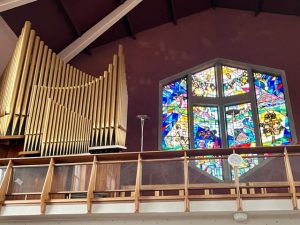 |
The fine pipe organ was brought to Corpus Christi from the Mary Ward Teachers Training College when it closed. |
| The other striking feature about the choir loft is the modern stained glass window depicting events from the bible from creation to the new covenant brought to man through Christ. Each panel depicts various events and so each is considered in turn below. We start with the centre two panels and then move anti-clockwise. Genesis tells us: “God planted a garden in Eden which is in the east and there he put the man he had fashioned.” The man is known as Adam, a collective noun for mankind. Later we are told the man named his wife ‘Eve’ because she was mother of all those who live. (‘Eve’ derives from the Hebrew verb ‘to live’) |
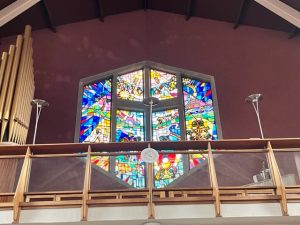 |
The Porch
The porch is the area first encountered when entering the church. A glass screen separates the porch from the nave. The view above is effectively what is seen from the porch.
Above the porch is the Choir Loft and nearby is the bookstall, where a variety of publications are available, and baptistry.
The Bookstall and Bapistry
If in the porch you turn right instead of going into the church you first see the bookstall and, just a little further on, the Bapistry.
| Catholic Newspapers can be obtained from the porch area. A variety of other Catholic publications can be obtained from the bookstall. | |
| The Baptistry is a section of a church, or even a separate room or building that contains the baptismal font and that is set aside for the celebration of the Rite of Baptism. It is near the main entrance to the church so that those to be baptised may be brought into the church spiritually as well as physically.
The font in our Baptistry is contructed out of marble. Baptisms often take place in the Sanctuary so that those who may accompany the candidate for Baptism can more easily see what is happening and be more fully part of the proceedings. More details about Baptism can be found in the Santuary Section of the Tour. |
The Lady Chapel
The Lady Chapel is a side chapel used for the celebration of the Mass on most weekdays, exposition (showing) of the Blessed Sacrament and for private prayer. There is an Icon of Our Lady of Perpetual Succour (i.e “Help”) and a statue of Our Lady.
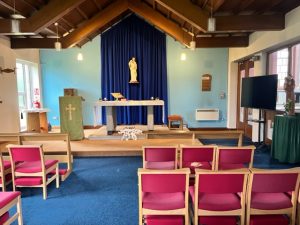 |
Icon of Our Lady of Perpetual Succour
An ‘icon’ is a Christian picture that tells a story or teaches a truth. Traditionally, icons have been associated with the Eastern Church, but they also play a part in the Western Church. The Icon in the Lady Chapel is of Our Lady of Perpetual Succour (or ‘Perpetual Help’). It tells of the Passion and death of Jesus and of the suffering of Mary his mother. The original picture of Our Lady of Perpetual Succour was painted on the island of Crete over 500 years ago. A merchant took the picture to Rome in 1498 and it remains there still. The first copy of the picture to leave Rome was brought to England by the Redemptorist order in 1866. Click here for the story told by the Icon. |
| The statue of Our Lady reminds us of the role Mary had in bring Jesus Christ, the Son of God, into the world. Mary, as mother, guided and supported her Child and , as in the Icon, she is depicted as supporting the Christ Child. But she also was instrumental in introducing and presenting him to the world, symbolised here by her right hand drawing back the covering over her child. The child Jesus is shown with arms extended, a gesture of greeting and welcome and indicating that eveyone is invited to come to him. Mary and the Christ Child are wearing white garments. White symbolises joy, purity and innocence. Here she is shown wearing a gold crown. Gold is used to symbolise heaven, the crown her Queenship. Amongst other descriptions, she is referred to as “Queen of Heaven”, not in a monarchical sense but in recognition of her special place as Mother of God. |
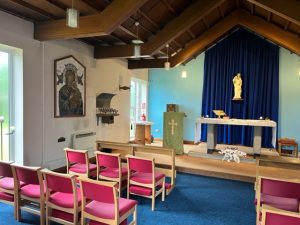 |
| The Lady Chapel is used for weekday Mass, for exposition of the Blessed Sacrament and for private prayer. Small candles, known as votive candles, may be lit to represent the prayers and petitions of those who light them. |

